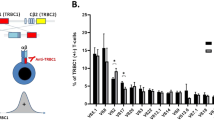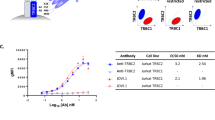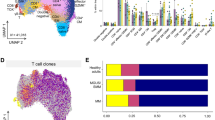Abstract
Clonal T cell populations with idiotype specificity are present in the peripheral blood of a proportion of patients with multiple myeloma. We have identified the presence of both T cell sub-populations with a specificity for autologous immunoglobin fragments and T cell receptor β gene rearrangements in peripheral blood samples of patients with myeloma. T cell receptor β gene rearrangements were detected in 38 of 119 patient samples (32%) and were more common in progressive disease (70%), than at diagnosis (25%) or in stable disease (23%). The 38 patients who had T cell receptor β gene rearrangements detected at any time had a better overall survival (median not yet achieved) than the patients who never had rearrangements detected (median 45 months, n = 49;χ 2 = 6.2, P < 0.01). All 12 patients with T cell receptor β gene rearrangements at diagnosis are still alive whereas the median survival for 28 patients with a germline configuration at diagnosis was 40 months (χ 2 = 5.8, P > 0.01). The presence of T cell receptor β gene rearrangements even conferred a survival advantage during progressive disease (median survival 44 months vs 19 months;χ2 = 8.7, P < 0.003). Two colour flow cytometry with biotinylated autologous immunoglobulin fragments demonstrated idiotype-reactive T cells in the peripheral blood of five out of 15 patients all of whom had T cell gene rearrangements. The remaining 10 patients had neither idiotype-reactive T cells nor a detectable T cell receptorβ gene rearrangement in concurrent samples. Thus in patients with myeloma there was a good correlation between the presence of T cell receptor β gene rearrangements and idiotype-reactive T cells. Patients with a rearranged T cell receptor β gene had a significantly better prognosis.
This is a preview of subscription content, access via your institution
Access options
Subscribe to this journal
Receive 12 print issues and online access
$259.00 per year
only $21.58 per issue
Buy this article
- Purchase on Springer Link
- Instant access to full article PDF
Prices may be subject to local taxes which are calculated during checkout
Similar content being viewed by others
Author information
Authors and Affiliations
Rights and permissions
About this article
Cite this article
Brown, R., Yuen, E., Nelson, M. et al. The prognostic significance of T cell receptor β gene rearrangements and idiotype-reactive T cells in multiple myeloma. Leukemia 11, 1312–1317 (1997). https://doi.org/10.1038/sj.leu.2400714
Received:
Accepted:
Issue Date:
DOI: https://doi.org/10.1038/sj.leu.2400714
Keywords
This article is cited by
-
Carfilzomib alters the HLA-presented peptidome of myeloma cells and impairs presentation of peptides with aromatic C-termini
Blood Cancer Journal (2016)
-
Multiple myeloma causes clonal T-cell immunosenescence: identification of potential novel targets for promoting tumour immunity and implications for checkpoint blockade
Leukemia (2016)
-
The cellular immune system in myelomagenesis: NK cells and T cells in the development of MM and their uses in immunotherapies
Blood Cancer Journal (2015)
-
Long-term survival in multiple myeloma is associated with a distinct immunological profile, which includes proliferative cytotoxic T-cell clones and a favourable Treg/Th17 balance
Blood Cancer Journal (2013)
-
Treatment of multiple myeloma with adoptively transferred chimeric NKG2D receptor-expressing T cells
Gene Therapy (2011)



